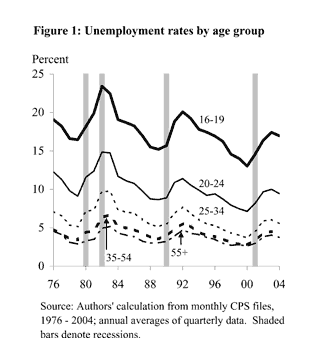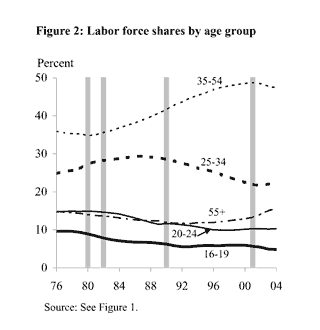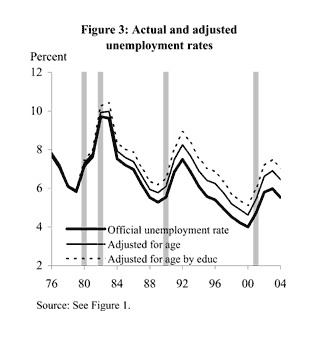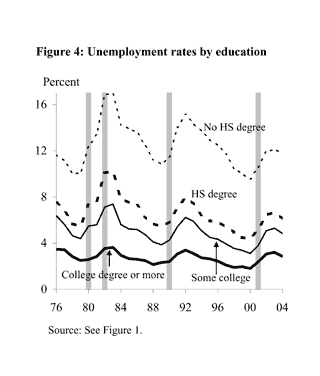The national unemployment rate fell slowly during the first half of 2005, reaching 5.0% in June. While this is above the lows reached in 1999-2000, it is noticeably below the rates that largely prevailed during the mid-1970s through the mid-1990s.
The national unemployment rate fell slowly during the first half of 2005, reaching 5.0% in June. While this is above the lows reached in 1999-2000, it is noticeably below the rates that largely prevailed during the mid-1970s through the mid-1990s. This Economic Letter focuses on two demographic factors that help explain the reduction in the unemployment rate over the past few decades. The first is the composition of the population by age group, and, in particular, the contribution of the aging of the “baby boom” generation to the long-term decline in the unemployment rate. The second is rising educational attainment among the population. In our analysis, we account for joint influences of age and education. Our results suggest that both factors made a significant contribution to the downward trend in the unemployment rate over the past few decades, although their influence was not large enough to fully account for the very low rates achieved near the most recent business cycle peak (years 1999-2000).




At least since Perry (1970), demographically adjusted unemployment rates have been used to understand how changes over time in labor force composition have contributed to trends in the unemployment rate. The most commonly applied demographic adjustment to the observed unemployment rate is based on changing labor force shares by age group. As Figure 1 illustrates, younger groups generally have noticeably higher unemployment rates than older groups; indeed, the difference is most striking for teenagers (age 16-19), whose unemployment rate typically is about three or more times that of people aged 35 and over. Informal observation and systematic analysis both point to high rates of job turnover among young workers as an explanation for higher equilibrium unemployment rates among these groups.
As a result of these differences in equilibrium unemployment rates by age, the movement of the large baby boom generation through the age distribution caused aggregate unemployment rates first to rise in the 1960s-1970s, when the share of young workers rose, and subsequently to fall, as the aging of the baby boom increased the labor force shares of prime-age workers, that is, those aged 35-54 (Figure 2). Changes in the sex composition of the labor force also have been used as a basis for adjusting the aggregate unemployment rate. However, the impact of adjustments for changing shares by sex has become quite small over the past few decades, due to convergence in unemployment rates between men and women and relative stability in women’s labor force shares since the 1980s (see, for example, Shimer 1999).
The impact of changing age composition on the unemployment rate can be assessed through calculation of an “age-adjusted unemployment rate.” This series is formed by multiplying each age group’s unemployment rate over time by its labor force share in a fixed base year. We use 1978 as the base year; Shimer (1999) identified 1978 as the “worst” year in recent U.S. history in demographic terms, in that the labor force shares of age groups with high unemployment rates were at their post-World War II peak (see Figure 2 for the list of age groups used). Figure 3 displays the official and age-adjusted unemployment rates as the two solid lines—the dotted line is a third series that is discussed below. The gap between the two series reflects rising labor force shares for age groups with lower unemployment rates; this gap grew noticeably during the 1980s and then grew only a bit more during the 1990s. Comparison of the two series across years is most informative when done at similar points in the business cycle. For example, the official unemployment rate declined by 1.8 percentage points between the business cycle peak years of 1979 and 2000, while the age-adjusted rate declined by 1.3 percentage points. The changing age structure of the labor force accounts for the difference between these two figures—0.5 percentage point, or just under 30 percent of the change in the actual unemployment rate. A slightly larger impact of changing age structure (0.7 percentage point) is uncovered when we examine the change in unemployment rates between the labor market troughs of 1982 and 2003; however, this represents a relatively small share of the change in the actual unemployment rate, which fell 3.7 percentage points between these trough years.
Following a line of reasoning similar to that used for age adjustments, past research also has investigated the merits of adjusting the aggregate unemployment rate for rising educational attainment (e.g., Summers 1986). Unemployment rates vary substantially by educational attainment, with individuals lacking a high school degree on average experiencing unemployment rates that are three to five times greater than the rates experienced by individuals with a college degree or more (Figure 4; all ages). In addition, educational attainment has risen steadily since the mid-1970s: the labor force share of individuals who attended at least some college rose from 33 to 57 percent between 1976 and 2004, with a corresponding drop in the share of individuals possessing a high school degree or less (data not shown).
Several aspects of the process by which educational attainment rises argue against the use of educational adjustments to the aggregate unemployment rate, especially when age and education adjustments are applied in an additive, independent manner. First, employers may care primarily about relative rather than absolute educational attainment in their hiring activities (Shimer 1999). If so, as educational attainment rises, the shrinking stock of less-educated individuals may consist of increasingly unattractive job candidates. The resulting rise in the unemployment rates of less-educated individuals would reinforce the estimated decrease in aggregate unemployment arising from their declining labor force share, resulting in an overestimate of the contribution of rising educational attainment per se to declining unemployment rates. Second, even if one accepts that adjusting the unemployment rate for rising educational attainment is conceptually reasonable, adding age and education adjustments together is likely to lead to an overstatement of their net effects, through “double counting” of age and cohort influences on educational attainment. For example, teenagers constitute a disproportionate share of individuals with low educational attainment; therefore, an adjustment that accounts for the reduction in the labor force share of individuals lacking a high school degree will reflect in part the aging of the labor force that has reduced the share of teenagers.
An adjustment to the aggregate unemployment rate based on changing shares of groups defined jointly by age and education avoids the problems inherent in separate, additive adjustments for age and education. In particular, as suggested by the argument in the previous paragraph, adjustments to the aggregate unemployment rate based on changing group shares rely heavily on the assumption that group-specific unemployment rates do not change in response to changes in group-specific labor force shares. Empirical tests conducted as part of this research indicated that, for the period we analyze, this assumption of independence between unemployment rates and labor-force shares is strongly violated when groups are defined by age or education alone, but for most years it is met quite closely when we divide the labor force by joint age and education groupings. Moreover, by separately identifying the changes in educational attainment by age group, the joint age/education grouping eliminates “double counting” of age and cohort effects on educational attainment.
The calculation we perform to obtain the unemployment series adjusted for joint changes in age and educational attainment is similar to that performed for the age-adjusted unemployment series, with 1978 as the base year once again. The group breakdown used for this calculation relies on four age and four education groups, for a total of sixteen groups (with two excluded, due to the very low incidence of college experience for 16-19 year olds). The resulting series is displayed in Figure 3 as the dotted line. As was the case for the age adjustment, the impact of the joint age and education adjustment was larger in the 1980s than in the 1990s. Comparing the official and adjusted series across comparable points in the business cycle, we find that changing labor force shares of groups defined jointly by age and education led to a reduction in the unemployment rate of 0.9 to 1 percentage point between the business cycle peaks and troughs of the late 1970s/early 1980s and the early 2000s; this equals about one-half to one-fourth of the overall decline in the unemployment rate (1.8 to 3.7 percentage points). As discussed above, the effect of changing age alone is equal to 0.5 to 0.7 percentage point, which is larger than the additional impact associated with the incorporation of changing education (0.3 to 0.4 percentage point).
Our results suggest that the aging of the labor force and rising educational attainment can account for a significant portion of the decline in the unemployment rate over the past two and a half decades. In particular, after adjusting the unemployment rate for these factors, we find that the rate in recent years is equal to a rate about one percentage point higher in terms of the age structure and educational attainment of the labor force around the year 1980. While the incorporation of education into demographic adjustments to the unemployment rate is not standard in the economics literature, our research findings support the inclusion of education over the period we examine, and its inclusion produces an overall adjustment that is within the numerical range of adjustments discussed in other work (see, for example, Shimer 1999).
Although rising age and education made important contributions, they explain only about one-half or less of the decline in the unemployment rate over the past few decades. This suggests that other factors contributed to the decline and help explain the very low unemployment rates—below 4.5%—achieved in 1999-2000. Indeed, prompted by the lengthy economic expansion of the 1990s, labor market conditions were unusually strong in 1999-2000. By contrast, employment growth has remained sluggish and uneven well into the current expansion, and the decline in the unemployment rate has been correspondingly slow.
Rob Valletta
Research Advisor
Jaclyn Hodges
Research Associate
Perry, George. 1970. “Changing Labor Markets and Inflation.” Brookings Papers on Economic Activity, pp. 411-448.
Shimer, Robert. 1999. “Why Is the U.S. Unemployment Rate So Much Lower?” In NBER Macroeconomics Annual 1998, eds. Ben S. Bernanke and Julio J. Rotemberg, pp. 11-61. Cambridge: MIT Press.
Summers, Lawrence. 1986. “Why Is the Unemployment Rate So Very High Near Full Employment?” Brookings Papers on Economic Activity 2, pp. 339-383.
Opinions expressed in FRBSF Economic Letter do not necessarily reflect the views of the management of the Federal Reserve Bank of San Francisco or of the Board of Governors of the Federal Reserve System. This publication is edited by Anita Todd and Karen Barnes. Permission to reprint portions of articles or whole articles must be obtained in writing. Please send editorial comments and requests for reprint permission to research.library@sf.frb.org